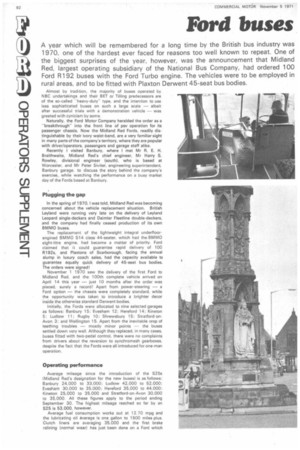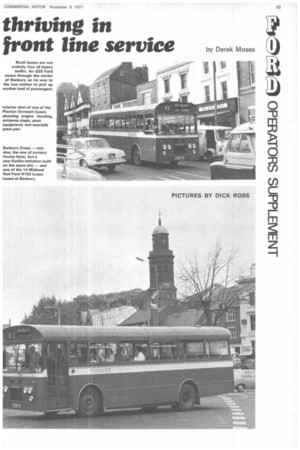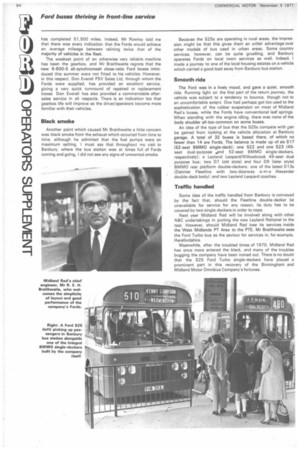Ford buses thriving in
Page 94

Page 95

Page 96

If you've noticed an error in this article please click here to report it so we can fix it.
front line service
Almost by tradition, the majority of buses operated by NBC undertakings and their BET or Tilting predecessors are of the so-called "heavy-duty" type, and the intention to use less sophisticated buses on such a large scale — albeit after successful trials with a demonstration vehicle — was greeted with cynicism by some.
Naturally, the Ford Motor Company heralded the order as a -breakthrough" into the front line of psv operation for its passenger chassis. Now the Midland Red Fords, readily distinguishable by their ivory waist-band, are a very familiar sight in many parts of the company's territory, where they are popular with driver/operators, passengers and garage staff alike.
Recently I visited Banbury. where I met Mr R. E. H. Braithwaite, Midland Red's chief engineer, Mr Harry S. Rowley, divisional engineer {south), who is based at Worcester, and Mr Peter Siviter, engineering superintendent, Banbury garage. to discuss the story behind the company's exercise,, while watching the performance on a busy market day of the Fords based at Banbury.
Plugging the gap
In the spring of 1970, I was told, Midland Red was becoming concerned about the vehicle replacement situation. British Leyland were running very late on the delivery of Leyland Leopard single-deckers and Daimler Fleetline double-deckers, and the company had finally ceased production of its own B M MO buses.
The replacement of the lightweight integral underfloorengined BMMO 514 class 44-seater, which had the BMMO eight-litre engine, had become a matter of priority. Ford claimed that it could guarantee rapid delivery of 100 R192s, and Plaxtons of Scarborough, facing the annual slump in luxury coach sales, had the capacity available to guarantee equally quick delivery of 45-seat bus bodies. The orders were signed!
November 1 1970 saw the delivery of the first Ford to Midland Red, and the 100th complete vehicle arrived on April 14 this year — just 10 months after the order was placed, surely a record! Apart from power-steering — a Ford option — the chassis were completely standard, while the opportunity was taken to introduce a brighter decor inside the otherwise standard Derwent bodies.
Initially, the Fords were allocated to nine selected garages as follows: Banbury 15; Evesham 12; Hereford 14; Kineton 5: Ludlow 11; Rugby 10; Shrewsbury 15; Stratford-onAvon 3; and Wellington 15. Apart from the inevitable crop of teething troubles — mostly minor points — the buses settled down very well. Although they replaced, in many cases, buses fitted with two-pedal control, there were no complaints from drivers about the reversion to synchromesh gearboxes. despite the fact that the Fords were all introduced for one-man operation.
to 35.000. All these figures apply to the period ending September 30. The highest mileage reached so far by an S25 is 53,000, however.
Average fuel consumption works out at 12.70 mpg and the lubricating oil average is one gallon to 1500 miles plus. Clutch liners are averaging 35,000 and the first brake relining (normal wear) has just been done on a Ford which has completed 51,500 miles. Indeed. Mr Rowley told me that there was every indication that the Fords would achieve an average mileage between relining twice that of the majority of vehicles in the fleet, The weakest point of an otherwise very reliable machine has been the gearbox. and Mr Braithwaite regrets that the new 6-600-S all-synchromesh close-ratio Ford boxes introduced this summer were not fitted to his vehicles. However, in this respect. Don Fverall PSV Sales Ltd, through whom the Fords were supplied, has provided an excellent service, giving a very quick turnround of repaired or replacement boxes. Don Everall has also provided a commendable aftersales service in all respects. There is an indication too that gearbox life will improve as the driver/operators become more familiar with their vehicles.
Black smoke
Another point which caused Mr Braithwaite a little concern was black smoke from the exhaust which occurred from time to time, although he admitted that the fuel pumps were on maximum setting. I must say that throughout my visit to Banbury, where the bus station was at times full of Fords coming and going, I did not see any signs of unwanted smoke. Because the 525s are operating in rural areas, the impression might be that this gives them an unfair advantage over other models of bus used in urban areas. Some country services, however, can be quite gruelling, and Banbury operates Fords on local town services as well. Indeed, I made a journey to one of the local housing estates on a vehicle which carried a good load away from Banbury bus station.
Smooth ride
The Ford was in a lively mood, and gave a quiet, smooth ride. Running light on the first part of the return journey, the vehicle was subject to a tendency to bounce, though not to an uncomfortable extent. One had perhaps got too used to the sophistication of the rubber suspension on most of Midland Red's buses, while the Fords have conventional leaf springs. When standing with the engine idling, there was none of the body shudder all-too-common on some buses.
An idea of the type of bus that the 525s compete with can be gained from looking at the vehicle allocation at Banbury garage. A total of 32 buses is based there, of which no fewer than 14 are Fords. The balance is made up of six $17 (52-seat BMMO single-deck); one S22 and one 523 (45seat dual-purpose ...and 52-seat BMMO single-deckers. respectively): a Leyland LeoparciNVillowbrook 49-seat dual purpose bus: two D7 (old style) and four D9 (later style) BMMO rear platform double-deckers: one of the latest D13s (Daimler Fleetline with two-doorway o-m-o Alexander double-deck body): and two Leyland Leopard coaches.
Traffic handled
Some idea of the traffic handled from Banbury is conveyed by the fact that, should the Fleetline double-decker be unavailable for service for any reason, its duty has to be covered by two single-deckers in order to cope.
Next year Midland Red will be involved along with other NBC undertakings in putting the new Leyland National to the test However. should Midland Red lose its services inside the West Midlands PT Area to the PTE, Mr Braithwaite sees the Ford Turbo bus as the saviour for services in, for example, Herefordshire. • Meanwhile, after the troubled times of 1970. Midland Red has once more entered the black, and many of the troubles bugging the company have been ironed out. There is no doubt that the 525 Ford Turbo single-deckers have played a prominent part in this recovery of the Birmingham and Midland Motor Omnibus Company's fortunes.




































































































































































